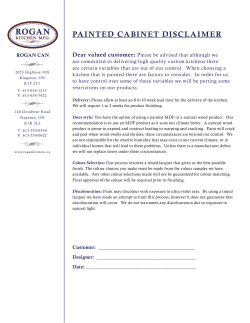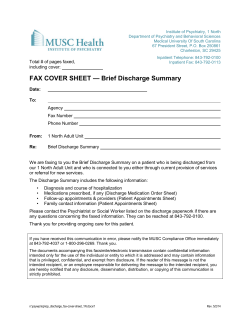
Fire Extinguishers: types and uses John Carmichael OH&S and IM
Fire Extinguishers: types and uses John Carmichael OH&S and IM Learning outcomes 1. 2. 3. 4. 5. 6. Describe the elements of fire Identify the classes of fire Identify extinguishing agents Identify types of fire extinguishers Identify when it is safe to fight a fire Demonstrate use of fire extinguishers Fire Chemical reaction in which heat, smoke, and light, is produced-called combustion. Combustion is sustained by the production of free radicals. Basic fire behaviour • Heat and smoke rises • Smoke will enter through small holes or gaps in most materials • Fire will spread out and upwards Stop the spread of fire and smoke Close Windows Close Doors Limits oxygen supply Confines the fire and smoke to a smaller area The four sides of this tetrahedron represent fire :• Heat • Oxygen • Fuel • Chemical Reaction Controlling a fire • HEAT – Cool • OXYGEN – Smother • FUEL – Starvation • CHEMICAL REACTION - Inhibit Cooling Water to cool the fire Water absorbs the heat Burning fuel Heated vapour Water is fairly cheap Very common method of extinguishment Smothering Reduce the oxygen supply to the fire • Sand or earth • Fire blankets • Powder and foam fire extinguishers Starvation Remove the fuel from fire Can be very difficult! Examples: Shut off gas Construct fire breaks Use non combustible materials Inhibiting the chemical reaction Apply a chemical reagent that inhibits flame reaction Classes of fires A” Class Fires “B” Class Fires “C” Class Fires “D” Class Fires “E” Class Fires “F” Class Fires Class “A” fires Ordinary Combustible Solids Wood, paper, cloth, plastics, rubber, coal, carbon based compounds etc. Class “B” fires Flammable & Combustible Liquids Petrol, oil, paint, thinners, kerosene, alcohol, etc. Class “C” fires Flammable Gases L.P.G., Butane, Acetylene, Hydrogen, natural gas and Methane etc. Class “D” fires Combustible Metals Magnesium, aluminium, sodium, lithium, calcium, potassium etc. Class “E” fires Electrical Fires Computers, switchboards, power-boards, etc. Class “F” fires Cooking Oils and Fats Chip cookers, deep fryers, etc. Extinguishing Agents • Dry Chemical / Powder • Carbon Dioxide (CO2) • Water • Foam Water Red colour Cooling Discharge time ~ 60 - 90 secs Range up to 6.0 m Note: Conducts Electricity Foam Blue colour band 90% water, 10% A.F.F.F. Cooling and smothering Discharge time ~ 60 seconds Range up to 4.5 m Note: Conducts Electricity Wet chemical Oatmeal colour band Cooling and smothering Discharge time ~ 60 seconds Range up to 4.5 m Ideal for industrial kitchens Note: Conducts Electricity Dry powder White colour band Inhibits flame reaction Smothering Discharge time ~ 10 - 15 secs Range up to 3.0 m Carbon dioxide (Co2) Black colour band Smothering Discharge time ~ 10 – 15 secs Range up to 2.0 m B.C.F. Fire Extinguishers Yellow in colour Toxic to humans Can cause death or unconsciousness Contact Maintenance to dispose Banned since 31 December 1995 Fire extinguishers Handle Service tag Nozzle Instructions Guage Pin Fire hose reels Hose nozzleadjustable spray Water on/off Water stream on/off Fire blanket Fire resistant fabric Smother flames Keep in kitchen One use only Signage Extinguisher location Discovering a fire Upon discovering a fire: 1. Assess the situation 2. Assist persons in the immediate area 3. Restrict the danger area/s 4. Raise the alarm 5. Attack the fire (Only if safe to do so) 6. Evacuate to safety When is it safe to attempt to fight a fire? • Not explosive in nature • Correct equipment • Properly trained • Size of fire • Safe escape • Alarm raised In conclusion • Fire extinguishers can help prevent small fires getting larger • Fire fighting is for the Firefighters • Don’t forget to look for fire fighting equipment in your work area! More information • Emergency management – http://safety.unimelb.edu.au/support/emergency/ • Security – http://www.pcs.unimelb.edu.au/services_a nd_requests/security_and_access/index.ht ml © Copyright The University of Melbourne 2011
© Copyright 2025




















